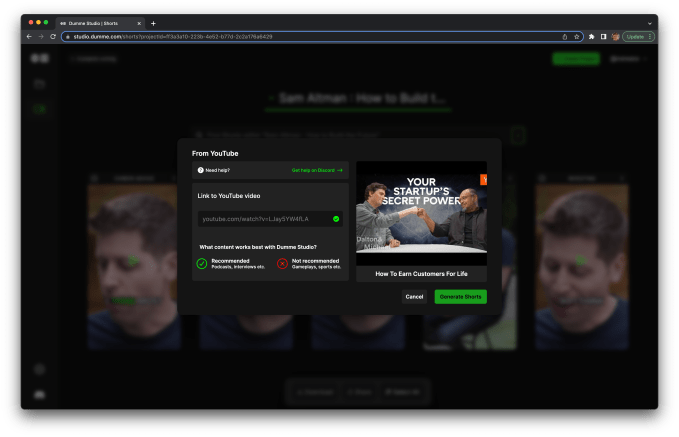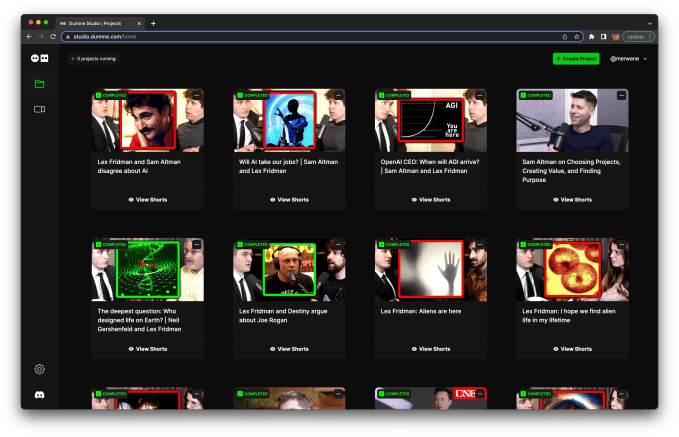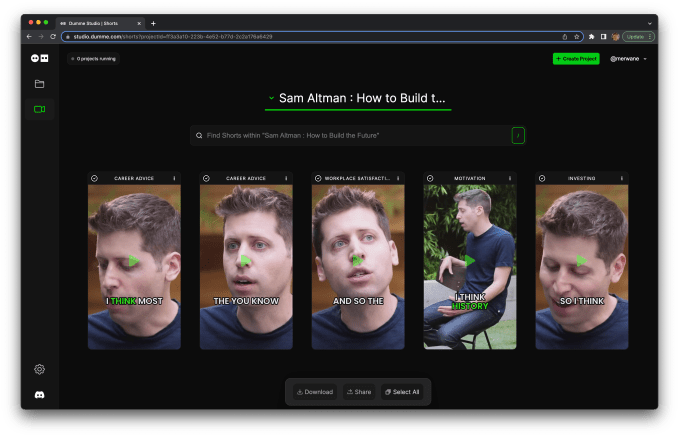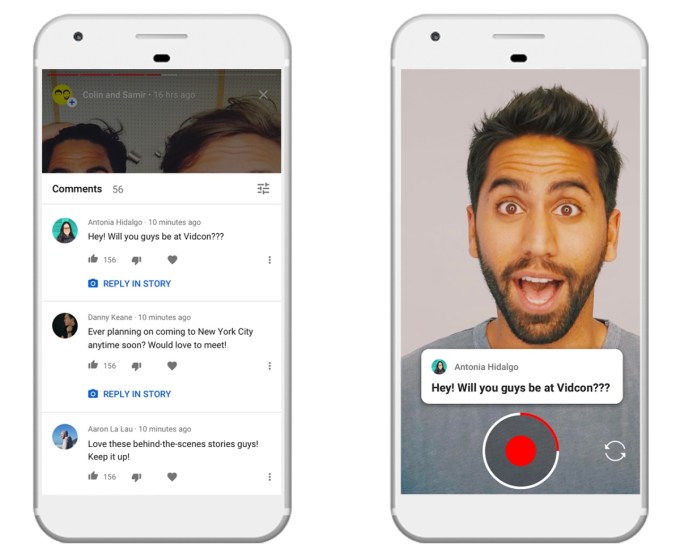This represents an over 8,000% increase from $1.8 million in the first quarter of 2023, when just 21 apps were available.
© 2024 TechCrunch. All rights reserved. For personal use only.
Steve Thomas - IT Consultant
This represents an over 8,000% increase from $1.8 million in the first quarter of 2023, when just 21 apps were available.
© 2024 TechCrunch. All rights reserved. For personal use only.
This gives Facebook a way to better compete against other popular video platforms that rely on algorithmic recommendations.
© 2024 TechCrunch. All rights reserved. For personal use only.
With TikTok potentially poised for a U.S. ban, YouTube is touting how well its own TikTok competitor, YouTube Shorts, is paying off for creators. The company on Thursday said its short-form video platform now averages over 70 billion daily views and over 25% of channels in YouTube’s Partner Progam monetize their videos through revenue-sharing on […]
© 2024 TechCrunch. All rights reserved. For personal use only.
YouTube Create, Google’s standalone mobile app aimed at creators, which helps them produce both Shorts and longer videos, is expanding to a broader set of markets after last fall’s launch into beta testing. The app was initially available on Android in the U.S. and a handful of other select markets, but today will become available […]
© 2024 TechCrunch. All rights reserved. For personal use only.
Lux, the startup and makers of the popular pro photography app Halide and others, is venturing into video. The team today announced its plans to debut a new app, Kino, arriving in roughly two months’ time, that will allow iPhone users to work with video in a more professional capacity. The news follows advances in […]
© 2023 TechCrunch. All rights reserved. For personal use only.
Two years after testifying before the U.S. Senate over child safety concerns, including teens’ exposure to eating disorder content, YouTube today announced additional product safeguards around its content recommendations aimed at teens. Specifically, the company said it would limit repeated recommendations of videos on topics that can trigger body image issues, like those comparing physical […]
© 2023 TechCrunch. All rights reserved. For personal use only.
X, formerly Twitter, CEO Linda Yaccarino confirmed today that video calls will be a new feature coming to the service, as part of its transformation into an “everything app.” Her comments were made during the exec’s first TV interview since leaving NBCUniversal and taking on the new role at the social networking app this June.
“Soon you’ll be able to make video chat calls without having to give your phone number to anyone on the platform,” Yaccarino told CNBC’s Sara Eisen, after listing other features that X offers or plans to, like long-form videos and creator subscriptions, as well as payments.
Ahead of this announcement, X designer Andrea Conway hinted about the new feature yesterday when she posted, “just called someone on X,” followed by four head-exploding emoji. However, it wasn’t clear at the time if she was referring to voice calls, video calls or both.
Her post now seems to indicate the calling feature Yaccarino announced is in active development.
Twitter owner Elon Musk has shared his plans for transforming the old Twitter into an everything app where users could subscribe to their favorite creators, watch videos, express their thoughts — including in 25,000-character long posts, upload funds, send payments, and even perhaps store cash in high-yield savings accounts.
The company has been moving quickly towards some of these goals, having last month opened up its revenue-sharing program with global creators, and recently adding support for two-hour videos. The latter was used by advertiser Apple to stream an entire episode of its Apple TV+ show “Silo.”
Last week, the company also snagged the @music handle for itself, suggesting possible interest in supporting musicians and artists, too.
In the interview, Yaccarino supported Musk’s sentiments around this “everything app” concept saying she joined the company with the understanding that transformation was the goal.
“When Elon announced me joining the company…he was very specific and very clear that I was joining him to help him transition Twitter to X, that everything app,” she said.
The CEO also clarified her role in comparison with Musk’s, when it comes to X’s future.
“Elon focuses on product design. He leads a team of extraordinary engineers and focuses on new technology,” she explained. “Elon is working on accelerating the rebrand and working on the future. And I’m responsible for the rest — running the company — from partnerships to legal to sales to finance to all the things…our roles are very clear.”
Dumme, a startup putting AI to practical use in video editing, is already generating demand before opening up to the public. The Y Combinator-backed company has hundreds of video creators testing its product, which leverages AI to create short-form videos from YouTube content, and a waitlist of over 20,000 pre-launch, it says. Using a combination of both proprietary and existing AI models, Dumme’s promise is that it can not only save on editing time but also — and here’s its big claim — do a better job than the contracted (human) workforce who is often tasked with more menial video editing jobs, like cutting down long-form content for publication on short-form platforms like YouTube Shorts, TikTok or Instagram Reels.
Founded in January 2022 and a participant in startup accelerator Y Combinator’s Winter 2022 program, Dumme co-founder and CEO Merwane Drai said he was originally focused on building a search engine for video. But around six months ago, the team realized that a better product might be to repurpose the same AI models they were developing to edit video clips instead.
Joined by co-founders Will Dahlstrom (CPO) and Jordan Brannan (CTO), all with AI backgrounds, Drai realized Dumme may have landed on the right product-market fit after their app went viral, crashing their servers.
“We didn’t really expect that it would get a lot of traction or anything, so we just put something out there,” Drai explains. “Then what happened is that overnight, we woke up to overloaded servers — like, nothing actually worked. So we took everything down and actually put together some sort of waitlist,” he continues. “The next morning, we probably woke up to 5,000 people in there, which was interesting.”
The team later discovered that a TikTok creator had posted a short video about the product, which sent a flood of traffic to their site.
“It actually never calmed down from that,” Drai notes.
The product, pronounced “dummy,” appealed to creators because it aimed to simplify and speed up the work involved with video editing.

Image Credits: Dumme
Using Dumme is as simple as the name implies. To get started, the user pastes in a YouTube video’s link, then clicks on “generate” and the AI will output a number of short videos showcasing highlights from that ingested content. The company says it’s using YouTube as the source, instead of supporting raw video footage, in order to outsource content moderation — that is, if it’s allowed on YouTube, it’s allowed in Dumme.
The processing time and the number of resulting clips will depend on the length of the original video.
But as an example, an hour-long video podcast might take around 20 minutes to process and you’ll start receiving clips after about five minutes, Drai says. When complete, creators can download the video clips, which are under 60 seconds by default, and upload them to any platform that supports short-form content, like YouTube Shorts, but also other platforms, like Reels or TikTok.

Image Credits: Dumme
How this all works on the backend, of course, is much more complex. The company says that, initially, Dumme will learn as much as it can from the source video via the metadata. It then transcribes the video and tries to understand the semantics of what’s being said while also looking at the frames to try to decode the emotions of the person speaking. These findings are correlated and passed to a language model that tries to determine what parts of the video are worthy of clipping. That’s then handed off to another model that tracks active speakers and handles cropping.
Dumme says it’s working with existing AI models like GPT-4, a fine-tuned version of Whisper, and others it built in-house — like the model that tracks the active speakers in a video frame. One of its models is also trained on a bunch of YouTube Shorts to learn what makes for a good opening hook to pull viewers in. And, though not yet live, the team is also experimenting with an open source model, LaViLa from Facebook Research, to better understand the context of the video.
The AI work is being done on GPU Cloud provider CoreWeave, not AWS, as it’s more affordable, the company tells us.
Because Dumme relies on AI that processes spoken words, the tech is not appropriate for things like long gameplay videos or others where people aren’t talking. Drai says the startup is initially targeting YouTube creators, podcasters, and agencies — the latter, they believe, would be the best bet for monetizing the product.

Image Credits: Dumme
Agencies, explains Drai, today often outsource this type of work with hit-or-miss results.
“They just pay contractors in cheap jurisdictions to edit their own content. And the problem is that it’s still actually pretty expensive and it takes a lot of time — it takes weeks, not minutes,” he says.
Asked how he feels about creating a technology that would actually put people out of work, Drai was not worried.
“The way I think about it is that, eventually…I think this is like telling me that math teachers are going to [be put] out of work because there’s something called a calculator…,” he explains. “People are going to adapt. And then there’s going to be someone teaching you about the calculator, right? So I think it’s just a matter of adapting to this,” Drai says.
Currently, the pricing being considered involves tiers where a business would pay $0.40 per minute of video processed, while smaller creators may instead opt for a monthly subscription that’s capped at 10 hours of content per month. (These numbers may change.) During testing, the product has been free to use.
Early adopters have been using Dumme for a variety of edits, including generating clips from their video podcasts to publish to Shorts, as well as cutting down other new videos and going through their back catalogs.
The product appears to be competitive with other AI technologies on the market, including that from creator company Jellysmack, which has been leveraging AI to turn longer YouTube videos into shorter videos, by cutting them, resizing them, and optimizing them for specific platforms — a result of its 2021 Kamua acquisition. Other tools doing similar work include things like Opus Clip, Vidyo.ai, Detail, TubeBuddy, Wisecut, and others. To what extent Dumme succeeds or fails will be on outperforming competitors on the quality of work and cost — metrics that are yet to be determined.
But some investors are placing their bets on Dumme. Ahead of launch, the startup raised a $3.4 million seed round from Y Combinator, Caffeinated Capital, Max and Nellie Levchin (through SciFi VC), Suhail Doshi, Nico Chinot, Protocol Labs, Chris Puscasiu, and other angels.
Given the interest and the sizable waitlist, Dumme says it’s aiming to onboard around 500 people every week. TechCrunch readers can jump the line using the invite code TECHCRUNCH until the slots run out.
YC-backed Dumme raises $3.4M for its AI video editor that turns long-form YouTube videos into Shorts by Sarah Perez originally published on TechCrunch
Stories are over — at least on YouTube, that is. The Google-owned video site announced today that YouTube Stories will be shutting down on June 26, 2023, as the company aims to focus on other key areas, like Shorts, Community posts, and live videos, in addition to its traditional long-form content. Creators will be alerted to the shutdown through various channels, like forum posts, in-app messages, reminders in YouTube Studio, and more, YouTube says.
Once copied by nearly every social app, Stories have lost traction in the wake of TikTok’s rise. These days, services are adopting the short-form vertical video format popularized by TikTok instead of the more ephemeral and casual Stories format.
YouTube isn’t alone in abandoning Stories, either. Netflix in years past had tested a Stories-like feature called “Extras” in its mobile app where it shared videos and photos from popular shows. The streamer later moved on to embrace vertical video with the launch of features like its short-form comedy videos feed, “Fast Laughs,” and a related vertical video feature aimed at kids. LinkedIn also abandoned its Stories feature in 2021. And while Spotify recently introduced a feature similar to Stories for artists’ profiles, the app’s larger redesign is one that prioritizes TikTok-like discovery feeds as its central focus.
First launched in 2018, YouTube officially rolled out Stories to creators with over 10,000 subscribers — but it never broadened access to everyone on YouTube to allow casual, personal sharing to really take off. The company had suggested at the time creators could use Stories to engage with their audience in between their more polished and produced videos for things like behind-the-scenes updates, vlogs, sneak peeks at upcoming videos, quick updates, and more.

Image Credits: YouTube
Like Stories on Instagram and Snapchat, YouTube Stories would disappear after a period of time — in this case, 7 days. It wasn’t possible to save Stories on a creator’s profile the way you can with Instagram’s Story Highlights, however.
It’s fair to say the feature saw limited adoption, especially given the success of other engagement tools like Community posts, which also let creators share quick updates, promote their content or have conversations with fans. In fact, YouTube essentially admits that Stories weren’t working, noting in today’s announcement that, among creators who used both Stories and Community posts, the latter drove “many times more comments and likes” compared to Stories. Access to Community posts recently expanded to a broader set of creators, as YouTube dropped the >500 subscriber requirement.
In addition, creators have shifted their efforts in short-form video over to YouTube Shorts. The company notes this format has also been more successful than Stories, as creators who used both, on average, saw “many times more subscribers” on Shorts than on Stories.
“As Shorts adoption grew on YouTube, we saw that creators benefited from this new format,” a YouTube spokesperson told TechCrunch about the changes. “Stories are going away so we can prioritize key areas that creators need to be successful. We’ll continue to invest in helping creators grow and connect with their audiences across formats,” they added.
In addition to a community forum post, creators who frequently use Stories will be alerted to their shutdown via a notification in YouTube Studio, in Help Center content, and YouTube will remind creators about the changes in an upcoming Creator Insider video, where it regularly publishes updates. Plus, there will be a notification directly in Stories, if creators access the feature prior to June 26.
On that date, it will no longer be possible to create a new YouTube Story, but Stories that are already live will still remain up for 7 days after they were originally shared, YouTube says.
YouTube Stories are shutting down June 26 as company focuses on Shorts by Sarah Perez originally published on TechCrunch
TikTok is partnering with big-name publishers, including NBCU, Condé Nast, DotDash Meredith, BuzzFeed, and others, in an effort to pull in more premium ad dollars. At this week’s NewFronts, the video entertainment company announced a new premium ad product that would allow marketers, for the first time, to position their brand ads directly after TikTok’s publisher and media partners’ content in over a dozen categories including lifestyle, sports, entertainment, education and more.
The ad slot, dubbed “Pulse Premiere,” offers a sort of brand-safe space within TikTok’s social video network, as they’re guaranteed their ads will run immediately after what TikTok refers to as “suitable TikToks” from premium publishers.
The move could address potential concerns over ad placement amid user-generated content that, in years past, has caused disruptions to YouTube’s ad revenue, as bands have had to freeze ads due to offensive and obscene material ranging from hate speech to child safety issues, and more.
With TikTok’s new offering, marketers can be assured of their placement as the content will run only alongside trusted publishers. In addition to NBCU, Condé Nast, DotDash Meredith, and BuzzFeed, the company is also partnering with Hearst Magazines, Major League Soccer, UFC, Vox Media and WWE on the new program.
In addition, marketers will be able to use TikTok’s ad platform to tie their campaigns to tentpole events through Pulse Premiere, the company says. Meanwhile, for publishers, the new ad slots will help them generate increased revenue from their TikTok investments by way of a revenue-sharing agreement.
TikTok declined to share how much the new Pulse Premiere ad placements will cost, saying only that they are “premium ad placements.” It also didn’t detail the revenue share for participating publishers.
“At Condé Nast the power of our brands allows us to create culture-defining content for 1B of the most engaged audiences across many relevant platforms,” said Pam Drucker Mann, Global Chief Revenue Officer & President, U.S. Revenue & APAC at Condé Nast, in a statement. “TikTok has become one of our most valuable partners, providing us with a variety of tools to ensure that our brands are driving these conversations on their platform. Our advertisers know that culture is the new KPI, and the Pulse Premiere solution finally enables clients to match media buying with how consumers are consuming our brands, like Vogue, GQ and Vanity Fair, on TikTok,” she added.
Pulse Premiere is built off TikTok’s initial Pulse offering launched last year, which allowed marketers to place their ads next to the top 4% of content on the platform. The program was the first ad product to offer a revenue share with content creators, TikTok noted at the time. The company says its data indicates TikTok users are 2.6x more likely to interact with a Pulse ad versus a comparable ad on another video platform. It also notes that Pulse campaigns increased brand recall by +9.8%, on average, and awareness by +6.8%.
However, in follow-up reports by Fortune, Insider, and others, creators reported extremely low earnings from Pulse — seeing revenue not even exceeding $5, in some cases. Among those creators interviewed by Insider, the revenue per every 1,000 video view on Pulse, or RPM, was in the range of just $6 to $8. One likened to nothing more than a small bonus for having a video go viral, but it’s clear creators are not meant to rely on the ad rev share to fuel their businesses.
Instead, TikTok offers other monetization tools for creators like livestream gifting, subscriptions, and a creator fund — though the latter has also been charged with paying out low amounts. Today, many creators make money through brand ad deals and sponsored content, not through the platform’s own tools for monetization.
The ad product will roll out to U.S. advertisers in the second half of the year with other markets to later follow.
TikTok partners with top publishers on its new premium and brand-safe ad slot, ‘Pulse Premiere’ by Sarah Perez originally published on TechCrunch